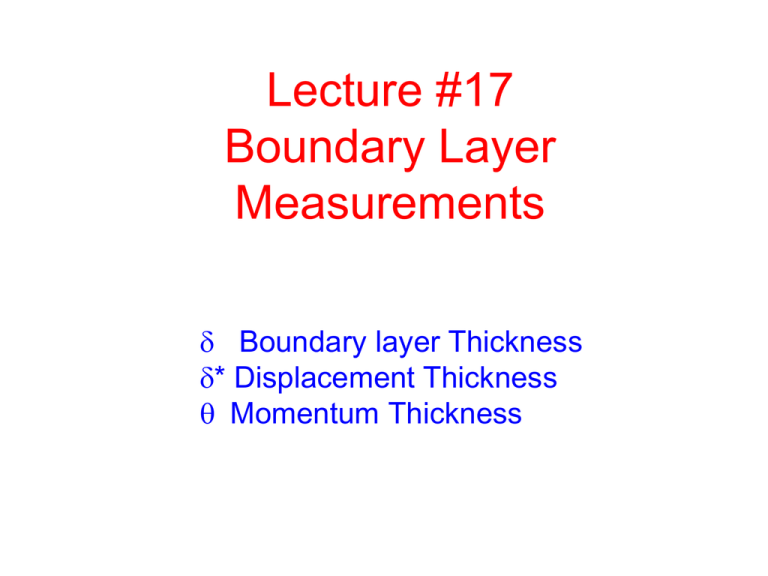Thermal Anemometry
advertisement

Lecture #17 Boundary Layer Measurements d Boundary layer Thickness d* Displacement Thickness q Momentum Thickness Objectives of this Lab • To obtain a better understanding of the characteristics of a boundary layer over an airfoil. • To gain an understanding of the value of using a constant temperature hot wire anemometry (CTA) to acquire boundary layer measurements. • Analyze both a laminar and turbulent boundary layer. • Compare data with boundary layer data for a flat plate. Instantaneous and Averaged Boundary Layer Profiles Recall NSF Film Boundary Layer Thickness Boundary layer Thickness Boundary layer thickness is generally defined as the height above the surface where the velocity reaches 99% of the freestream velocity. Displacement Thickness Laminar B.L. Momentum Thickness The rate of mass flow across an element of the boundary layer is (r u dy) and the mass has a momentum (r u2 dy ) The same mass outside the boundary layer has the momentum (r u ue dy) Q is a measure of the reduction in momentum transport in the Boundary Layer Empirical Equations of Laminar Boundary Layer Parameters • Boundary Layer Thickness • Displacement Thickness • Momentum Thickness • Skin Friction Coefficient Empirical Equations of Turbulent Boundary Layer Parameters • Boundary Layer Thickness • Displacement Thickness • Momentum Thickness • Skin Friction Coefficient Skin Friction Coefficient Mean and Fluctuating Streamwise Velocity Components • Velocity in streamwise • Instantaneous, mean direction and RMS velocities From Bertin and Smith Reference 1 Hot Wire Calibration • Determine relationship between Hot Wire Output Voltage, E and the Actual Mean Flow Velocity • King’s Law Hot Wire Anemometer Thermal Anemometry • • • • Frequency Response: > 200 Kilohertz Size: 5mm in diameter by 2mm long Velocity range Component Resolution: Hot wires can be used to resolve one , two and three components of flow field velocity. • Accuracy: Hot wires are very repeatable. Accuracy is really a function of how closely the calibration conditions are reproduced. Velocities can be measured to within < 2% of the actual velocity. • Resolution: One part in 10,000 can be accomplished with a hot wire system. Influence of Adverse Pressure Gradient Adverse Pressure Gradient dp/dx>0 can cause flow separation Turbulent Boundary Layer Measurements over a Flat Plate From White Reference 2 References • 1. White, F. M., Viscous Fluid Flow, McGraw-Hill, New York, 1991. • 2. Bertin , J. J., and Smith, M. L., Aerodynamics for Engineers, Prentice Hall, Englewood Cliffs, New Jersey, 1989 • Schlichting, H., Boundary Layer Theory, 7th edition, McGraw-Hill, New York, 1979.







